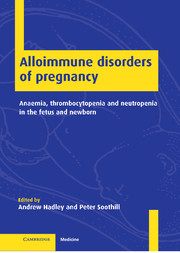 Alloimmune Disorders of Pregnancy
Alloimmune Disorders of Pregnancy Book contents
- Frontmatter
- Contents
- List of contributors
- Preface
- Foreword
- List of abbreviations
- 1 Pathophysiology of the alloimmune cytopenias
- 2 Blood group antibodies in haemolytic disease of the fetus and newborn
- 3 Basis and practice of screening for haemolytic disease of the fetus and newborn
- 4 Epidemiology and screening for alloimmune thrombocytopenia
- 5 Principles of antibody-mediated immune suppression and the prevention of maternal RhD alloimmunization
- 6 The clinical application of anti-D prophylaxis
- 7 Fetal genotyping
- 8 Laboratory assays to determine the severity of haemolytic disease of the fetus and newborn
- 9 Assessing the severity of haemolytic disease of the fetus and newborn: clinical aspects
- 10 Antenatal therapy for haemolytic disease of the fetus and newborn
- 11 Neonatal therapy for haemolytic disease of the newborn
- 12 The diagnosis of alloimmune thrombocytopenia
- 13 The immunological diagnosis of alloimmune neutropenia
- 14 Fetal and neonatal treatment of alloimmune thrombocytopenia
- Index
10 - Antenatal therapy for haemolytic disease of the fetus and newborn
Published online by Cambridge University Press: 26 October 2009
- Frontmatter
- Contents
- List of contributors
- Preface
- Foreword
- List of abbreviations
- 1 Pathophysiology of the alloimmune cytopenias
- 2 Blood group antibodies in haemolytic disease of the fetus and newborn
- 3 Basis and practice of screening for haemolytic disease of the fetus and newborn
- 4 Epidemiology and screening for alloimmune thrombocytopenia
- 5 Principles of antibody-mediated immune suppression and the prevention of maternal RhD alloimmunization
- 6 The clinical application of anti-D prophylaxis
- 7 Fetal genotyping
- 8 Laboratory assays to determine the severity of haemolytic disease of the fetus and newborn
- 9 Assessing the severity of haemolytic disease of the fetus and newborn: clinical aspects
- 10 Antenatal therapy for haemolytic disease of the fetus and newborn
- 11 Neonatal therapy for haemolytic disease of the newborn
- 12 The diagnosis of alloimmune thrombocytopenia
- 13 The immunological diagnosis of alloimmune neutropenia
- 14 Fetal and neonatal treatment of alloimmune thrombocytopenia
- Index
Summary
Introduction
Intrauterine blood transfusion of anaemic fetuses represents one of the great successes of fetal therapy. The therapeutic success of other potential therapies for HDFN, such as plasmapheresis, intravenous immune globulin, immunoabsorption, oral tolerance and chemotherapeutic agents, has been met with more mixed views.
Plasmapheresis and intravenous immune globulin
Plasmapheresis
An interest in plasmapheresis for the in utero treatment of HDFN preceded the improved perinatal survival realized in the late 1980s with modern intrauterine transfusion techniques. Most of the literature has reported single cases or relatively small case series (Table 10.1). Many of the studies used the historical control of the outcome of the patient's previous affected pregnancy to assess a therapeutic effect. In addition, plasmapheresis has often been combined with intrauterine transfusion or intravenous immune globulin (IVIG) making assessment of its effect more difficult. Despite these limitations, a review of the published cases reveals a perinatal survival of 69%. This would appear to warrant further scientific investigation into the use of plasmapheresis as an adjunct in the management of the severely alloimmunized patient. A randomized clinical trial was attempted by the Canadian Apheresis Study Group, but, unfortunately, insufficient enrolment necessitated premature termination of the study.
Reported protocols vary considerably but all involve repeated procedures due to a rebound increase in antibody titre. In animal studies, Bystryn and coworkers experimentally lowered antibody levels by exchange transfusion. Antibody levels were noted to rebound to over 200% of the initial levels with increases of up to 50–80% being seen even in the first 48 hours.
- Type
- Chapter
- Information
- Alloimmune Disorders of PregnancyAnaemia, Thrombocytopenia and Neutropenia in the Fetus and Newborn, pp. 173 - 202Publisher: Cambridge University PressPrint publication year: 2001
- 2
- Cited by


